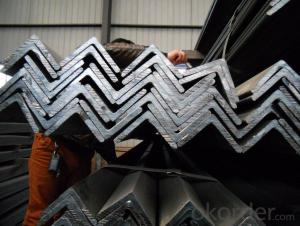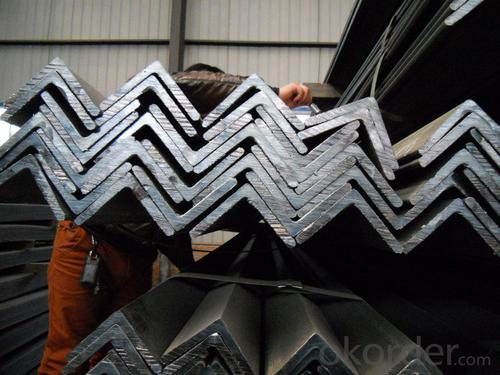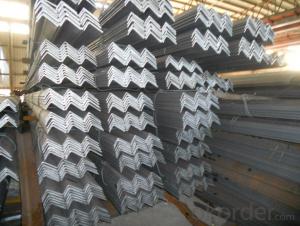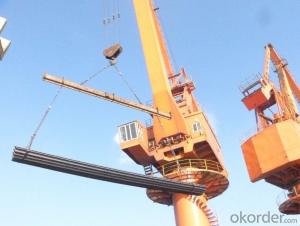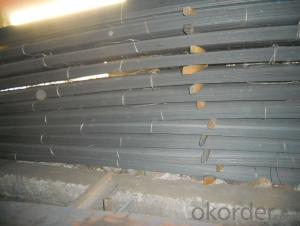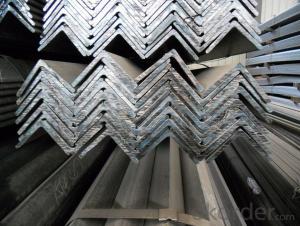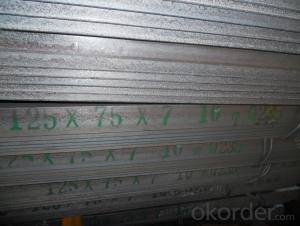Hot Rolled Equal Angle Steel Bar Different Sizes High Quality
- Loading Port:
- China Main Port
- Payment Terms:
- TT or LC
- Min Order Qty:
- -
- Supply Capability:
- -
OKorder Service Pledge
OKorder Financial Service
You Might Also Like
Product Description:
OKorder is offering Angle Bar at great prices with worldwide shipping. Our supplier is a world-class manufacturer of steel, with our products utilized the world over. OKorder annually supplies products to European, North American and Asian markets. We provide quotations within 24 hours of receiving an inquiry and guarantee competitive prices.
Product Applications:
According to the needs of different structures, Angle can compose to different force support component, and also can be the connections between components. It is widely used in various building structures and engineering structures such as roof beams, bridges, transmission towers, hoisting machinery and transport machinery, ships, industrial furnaces, reaction tower, container frame and warehouse etc.
.
Product Advantages:
OKorder's Angle Bar are durable, strong, and resist corrosion.
Main Product Features:
· Premium quality
· Prompt delivery & seaworthy packing (30 days after receiving deposit)
· Corrosion resistance
· Can be recycled and reused
· Mill test certification
· Professional Service
· Competitive pricing
Product Specifications:
Name | Stainless Steel Angles | ||||||
Standard | ASTM A554, A312, A249, A269 and A270 | ||||||
Material Grade | 304,316,201,202, 316L,430 | ||||||
Length | 6m or as customers' request | ||||||
Tolerance | a) thickness: +/-0. 15mm | ||||||
b) Length:+/-4. 5mm - 0mm | |||||||
Surface | 180G, 320G, 400G Satin / Hairline(Matt Finish, Brush, Dull Finish) 400G, 500G, 600G or 800G Mirror finish | ||||||
Application | Decoration construction, upholstery, industry instruments | ||||||
Test | Squash test, Extended test, Water pressure test, Crystal rot test, Heat treatment, NDT | ||||||
Chemical Composition of Material | Composition Material | 201 | 202 | 304 | 316L | 430 | |
C | ≤0.15 | ≤0.15 | ≤0.08 | ≤0.08 | ≤0.12 | ||
Si | ≤1.00 | ≤1.00 | ≤1.00 | ≤1.00 | ≤1.00 | ||
Mn | 5.5-7.5 | 7.5-10 | ≤2.00 | ≤2.00 | ≤1.00 | ||
P | ≤0.06 | ≤0.06 | ≤0.045 | ≤0.045 | ≤0.040 | ||
S | ≤0.03 | ≤0.03 | ≤0.030 | ≤0.030 | ≤0.030 | ||
Cr | 16-18 | 17-19 | 18-20 | 16-18 | 16-18 | ||
Ni | 3.5-5.5 | 4-6 | 8-10.5 | 10-14 | |||
Mo | 2.0-3.0 | ||||||
Mechanical Property | Material Item | 201 | 202 | 304 | 316L | ||
Tensile Strength | ≥535 | ≥520 | ≥520 | ≥520 | |||
Yield Strength | ≥245 | ≥205 | ≥205 | ≥205 | |||
Extension | ≥30% | ≥30% | ≥35% | ≥35% | |||
Hardness (HV) | <253 | <253 | <200 | <200 | |||
FAQ:
Q1: Why buy Materials & Equipment from OKorder.com?
A1: All products offered byOKorder.com are carefully selected from China's most reliable manufacturing enterprises. Through its ISO certifications, OKorder.com adheres to the highest standards and a commitment to supply chain safety and customer satisfaction.
Q2: How do we guarantee the quality of our products?
A2: We have established an advanced quality management system which conducts strict quality tests at every step, from raw materials to the final product. At the same time, we provide extensive follow-up service assurances as required.
Q3: How soon can we receive the product after purchase?
A3: Within three days of placing an order, we will begin production. The specific shipping date is dependent upon international and government factors, but is typically 7 to 10 workdays.
Q4: What makes stainless steel stainless?
A4: Stainless steel must contain at least 10.5 % chromium. It is this element that reacts with the oxygen in the air to form a complex chrome-oxide surface layer that is invisible but strong enough to prevent further oxygen from "staining" (rusting) the surface. Higher levels of chromium and the addition of other alloying elements such as nickel and molybdenum enhance this surface layer and improve the corrosion resistance of the stainless material.
Q5: Can stainless steel rust?
A5: Stainless does not "rust" as you think of regular steel rusting with a red oxide on the surface that flakes off. If you see red rust it is probably due to some iron particles that have contaminated the surface of the stainless steel and it is these iron particles that are rusting. Look at the source of the rusting and see if you can remove it from the surface.
Images:
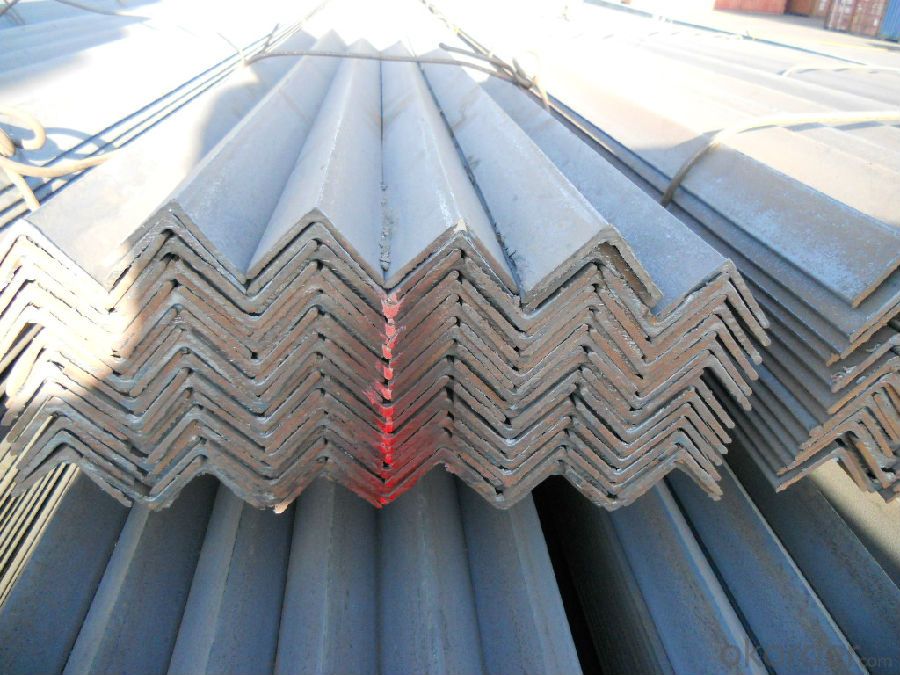
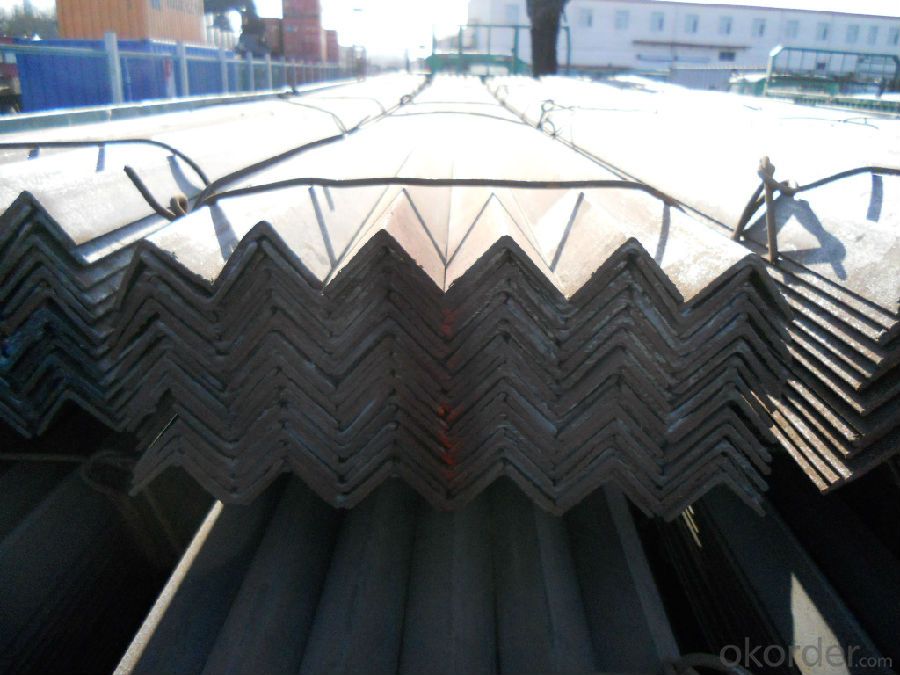
- Q: How are steel angles priced?
- Steel angles are priced based on various factors including the quality and grade of the steel, the supply and demand in the market, the size and dimensions of the angle, and any additional processing or finishing required.
- Q: Are steel angles suitable for mezzanine floor construction?
- Indeed, steel angles prove to be suitable for the construction of mezzanine floors. Mezzanine floor construction commonly incorporates steel angles due to their robustness and long-lasting nature. They offer exceptional support and stability, thereby making them an ideal choice for bearing the weight of the mezzanine floor and any additional loads placed upon it. By simply bolting or welding steel angles together, a sturdy framework can be easily created for the mezzanine floor. Moreover, steel angles can be tailored to meet specific design requirements, thereby allowing for flexibility in mezzanine floor construction. In summary, steel angles provide a dependable and cost-effective solution for the construction of mezzanine floors.
- Q: How are steel angles used in construction?
- Steel angles are commonly used in construction for a variety of purposes. One of the main uses of steel angles is to provide structural support and reinforcement in buildings and other structures. They are often used to create strong and stable connections between different components, such as beams, columns, and trusses. Steel angles are typically used to form the framework of a structure, providing stability and strength. They can be used to form corners, support beams, and brace walls. Steel angles are also frequently used to create lintels, which are horizontal supports placed above doors and windows to distribute the weight of the structure and prevent sagging. In addition to their structural uses, steel angles can also be used for aesthetic purposes in construction. They can be used to create decorative edging or trim, adding visual appeal to a building. Steel angles can also be used to create staircases, handrails, and other architectural features. Overall, steel angles are versatile and essential components in construction. They provide structural support, reinforcement, and aesthetic elements to ensure the durability, stability, and visual appeal of buildings and other structures.
- Q: What are the different surface finishes available for steel angles?
- Steel angles can be finished in various ways, depending on their intended use and desired appearance. Here are some common surface finishes for steel angles: 1. The mill finish is the standard, smooth finish that comes directly from the mill. It is a basic finish that is often chosen when appearance is not a major concern. 2. Hot-dip galvanizing involves immersing the steel angles in molten zinc to create a protective coating. This finish is ideal for outdoor or high-moisture environments due to its excellent corrosion resistance. 3. Powder coating is applied electrostatically as a dry powder, which is then cured under heat. It offers a durable and visually appealing finish, with a wide range of colors and textures to choose from. 4. Painting is another option, and different types of paint like epoxy, enamel, or acrylic can be used. Painting adds an extra layer of protection against corrosion and allows for customization in terms of color and appearance. 5. Stainless steel angles are inherently corrosion-resistant and commonly used in applications where hygiene, durability, and aesthetics are important, such as in food processing or architectural projects. 6. Shot blasting involves propelling small steel shots at high velocity onto the surface of the angles. This process removes mill scale, rust, and impurities, resulting in a clean and roughened surface that enhances adhesion for subsequent coatings or paints. These examples highlight the different surface finishes available for steel angles. The choice of finish depends on factors such as the intended use, environmental conditions, desired appearance, and budget. It is advisable to consult with a steel supplier or manufacturer to determine the most suitable surface finish for a specific application.
- Q: Can steel angles be used for HVAC ductwork support?
- Yes, steel angles can be used for HVAC ductwork support. Steel angles are commonly used in construction projects for their strength and durability. They provide excellent support for various applications, including HVAC ductwork systems. Steel angles can be easily fabricated and installed to create a sturdy framework for ductwork, ensuring stability and proper functioning of the system. Additionally, steel angles can withstand the weight and pressure exerted by the ductwork and are resistant to corrosion, making them a suitable choice for long-term use.
- Q: How much is a galvanized angle L50*50*5*2500
- Probably around 40 yuan
- Q: How are steel angles tested for quality control?
- To ensure that steel angles meet the required standards and specifications, various testing methods are employed for quality control. Trained inspectors conduct visual inspections to detect surface defects like cracks, dents, or uneven surfaces, which could compromise the angles' structural integrity. Another method used for quality control is dimensional inspection, where measurements of length, width, and thickness are taken to ensure that the angles adhere to specified tolerances. This is crucial as deviations from the required dimensions can affect the angles' performance and fit in different applications. Mechanical testing is also conducted to assess the steel angles' mechanical properties. Tests such as tensile strength, yield strength, and elongation are performed. Tensile strength measures the maximum amount of stress the angles can bear before breaking, while yield strength indicates the stress at which permanent deformation occurs. Elongation determines the angles' ability to stretch without fracturing, providing insights into their ductility. Chemical composition analysis is another critical step in quality control. It verifies that the steel angles contain the correct proportions of alloying elements and impurities. Techniques like spectrometry are utilized to ensure compliance with the required chemical composition standards. Furthermore, non-destructive testing methods are employed to identify internal defects or inconsistencies in the steel angles without causing damage. Techniques such as ultrasonic testing, magnetic particle testing, and radiographic testing are utilized to detect potential flaws like cracks, voids, or inclusions that may not be visible to the naked eye. In summary, a combination of visual inspection, dimensional inspection, mechanical testing, chemical composition analysis, and non-destructive testing is employed to ensure the quality and integrity of steel angles. These rigorous quality control measures guarantee that the angles meet the necessary standards and can perform their intended functions safely and reliably.
- Q: Can steel angles be used in seismic or earthquake-resistant construction?
- Seismic or earthquake-resistant construction can indeed make use of steel angles. These angles are commonly employed in structural applications due to their ability to provide strength and stability to a building. The main objective in seismic construction is to create structures capable of withstanding the powerful forces unleashed by an earthquake. Steel angles can be utilized in various ways to enhance a structure's resistance to seismic activity. One common application involves using them as bracing elements. These bracing systems help distribute the seismic forces throughout the building, reducing the risk of collapse. Steel angles can be employed as diagonal bracing members, adding strength and rigidity to the structure. Furthermore, steel angles can serve as moment-resisting frames in seismic design. These frames are designed to dissipate and absorb the energy generated during an earthquake. By incorporating steel angles into the frame, the building can effectively counteract lateral forces and maintain stability during seismic events. Moreover, steel angles are crucial in the construction of steel moment frames, which are widely used in seismic design. These frames consist of steel columns and beams connected by steel angles or other connections capable of resisting earthquake-induced forces. Steel angles play a vital role in transferring forces between different frame members, ensuring overall stability and structural integrity. In conclusion, steel angles can be effectively utilized in seismic or earthquake-resistant construction. Their strength and versatility make them suitable for bracing systems, moment-resisting frames, and steel moment frames, all of which contribute to enhancing a structure's seismic resistance. However, it is essential to ensure that the design and installation of steel angles comply with relevant building codes and regulations to guarantee the safety and durability of the construction.
- Q: What are the environmental impact considerations of using steel angles?
- The environmental impact considerations of using steel angles include the extraction and processing of raw materials, such as iron ore and coal, which contribute to deforestation, habitat destruction, and air pollution. Steel production also requires large amounts of energy, leading to greenhouse gas emissions and climate change. Additionally, the transportation and disposal of steel angles can further contribute to carbon emissions and waste generation. However, steel angles have a long lifespan and can be recycled, reducing the need for new production and minimizing their overall environmental impact.
- Q: What is the cost of steel angles compared to other structural materials?
- Various factors, such as market conditions, availability, and specific requirements, can cause the cost of steel angles to vary in comparison to other structural materials. However, as a rule, steel angles are often seen as a cost-effective choice for structural applications. When compared to materials like concrete or timber, steel angles are generally considered more affordable due to their relatively low production costs. Steel is readily available, and advancements in production techniques have resulted in competitive pricing. Furthermore, steel angles offer an exceptional strength-to-weight ratio, enabling lighter and more cost-efficient structural designs. Compared to other metals like aluminum or stainless steel, steel angles are typically more cost-effective. While aluminum and stainless steel may have certain advantages in terms of corrosion resistance or aesthetic appeal, their production processes and material properties tend to make them more expensive. It is worth noting that the exact cost of steel angles can vary depending on specific dimensions, quality, and quantity requirements. Prices may also fluctuate due to market conditions, such as changes in raw material costs or global supply and demand dynamics. Therefore, it is advisable to consult suppliers or industry professionals for accurate and up-to-date pricing information for steel angles.
Send your message to us
Hot Rolled Equal Angle Steel Bar Different Sizes High Quality
- Loading Port:
- China Main Port
- Payment Terms:
- TT or LC
- Min Order Qty:
- -
- Supply Capability:
- -
OKorder Service Pledge
OKorder Financial Service
Similar products
Hot products
Hot Searches
Related keywords
